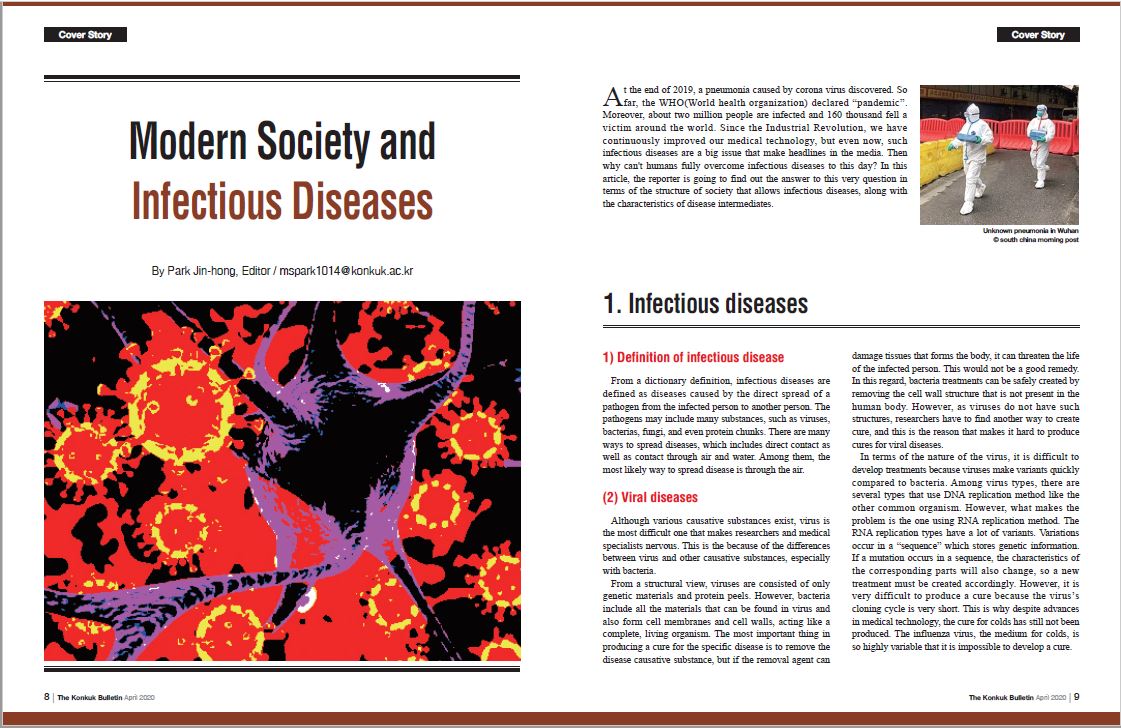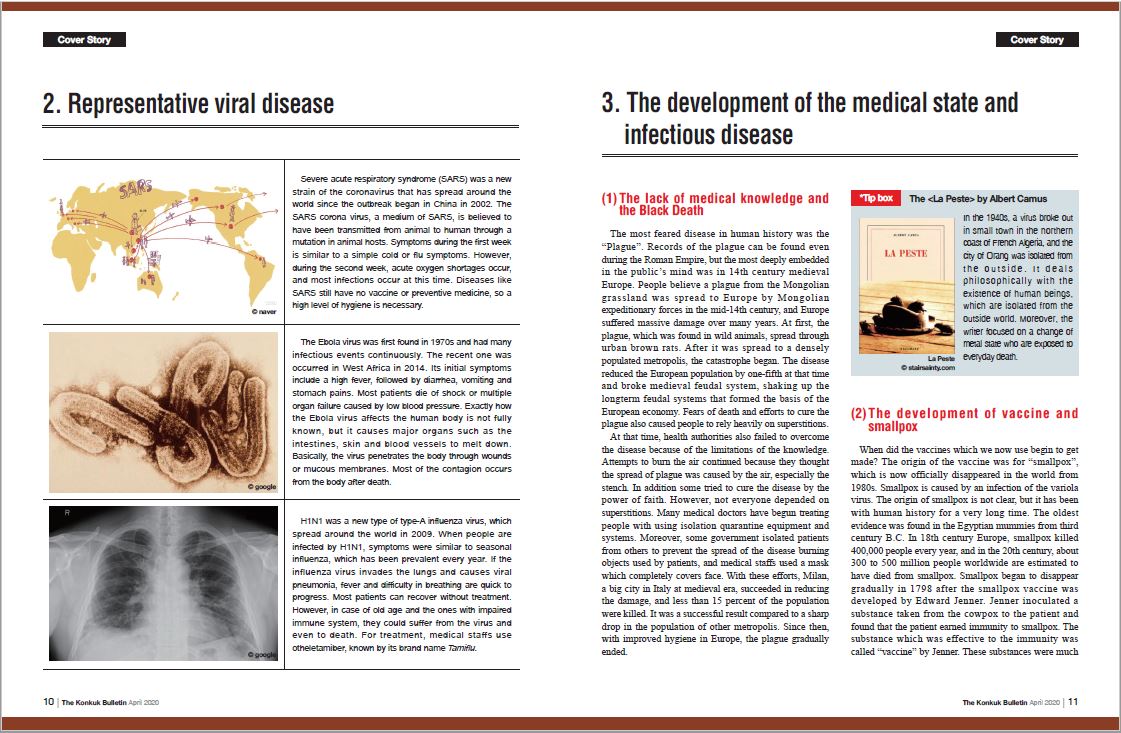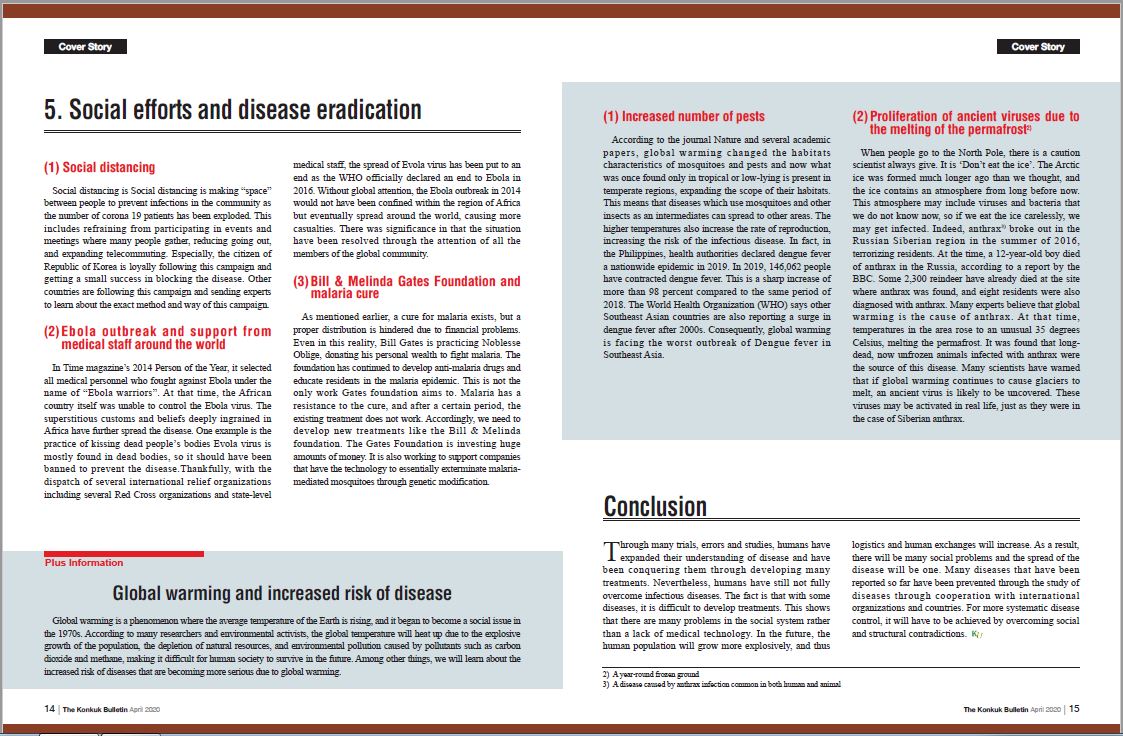



At the end of 2019, a pneumonia caused by corona virus discovered. So far, the WHO(World health organization) declared “pandemic”. Moreover, about two million people are infected and 160 thousand fell a victim around the world. Since the Industrial Revolution, we have continuously improved our medical technology, but even now, such infectious diseases are a big issue that make headlines in the media. Then why can't humans fully overcome infectious diseases to this day? In this article, the reporter is going to find out the answer to this very question in terms of the structure of society that allows infectious diseases, along with the characteristics of disease intermediates.
1. Infectious diseases
1) Definition of Infectious disease
From a dictionary definition, infectious diseases are defined as diseases caused by the direct spread of a pathogen from the infected person to another person. The pathogens may include many substances, such as viruses, bacterias, fungi, and even protein chunks. There are many ways to spread diseases, which includes direct contact as well as contact through air and water. Among them, the most likely way to spread disease is through the air.
(2) Viral diseases
Although various causative substances exist, virus is the most difficult one that makes researchers and medical specialists nervous. This is the because of the differences between virus and other causative substances, especially with bacteria.
From a structural view, viruses are consisted of only genetic materials and protein peels. However, bacteria include all the materials that can be found in virus and also form cell membranes and cell walls, acting like a complete, living organism. The most important thing in producing a cure for the specific disease is to remove the disease causative substance, but if the removal agent can damage tissues that forms the body, it can threaten the life of the infected person. This would not be a good remedy. In this regard, bacteria treatments can be safely created by removing the cell wall structure that is not present in the human body. However, as viruses do not have such structures, researchers have to find another way to create cure, and this is the reason that makes it hard to produce cures for viral diseases.
In terms of the nature of the virus, it is difficult to develop treatments because viruses make variants quickly compared to bacteria. Among virus types, there are several types that use DNA replication method like the other common organism. However, what makes the problem is the one using RNA replication method. The RNA replication types have a lot of variants. Variations occur in a “sequence” which stores genetic information. If a mutation occurs in a sequence, the characteristics of the corresponding parts will also change, so a new treatment must be created accordingly. However, it is very difficult to produce a cure because the virusʼs cloning cycle is very short. This is why despite advances in medical technology, the cure for colds has still not been produced. The influenza virus, the medium for colds, is so highly variable that it is impossible to develop a cure.
2. Representative viral disease
SARS
Severe acute respiratory syndrome (SARS) was a new strain of the coronavirus that has spread around the world since the outbreak began in China in 2002. The SARS corona virus, a medium of SARS, is believed to have been transmitted from animal to human through a mutation in animal hosts. Symptoms during the first week is similar to a simple cold or flu symptoms. However, during the second week, acute oxygen shortages occur, and most infections occur at this time. Diseases like SARS still have no vaccine or preventive medicine, so a high level of hygiene is necessary.
Ebola
The Ebola virus was first found in 1970s and had many infectious events continuously. The recent one was occurred in West Africa in 2014. Its initial symptoms include a high fever, followed by diarrhea, vomiting and stomach pains. Most patients die of shock or multiple organ failure caused by low blood pressure. Exactly how the Ebola virus affects the human body is not fully known, but it causes major organs such as the intestines, skin and blood vessels to melt down. Basically, the virus penetrates the body through wounds or mucous membranes. Most of the contagion occurs from the body after death.
H1N1
H1N1 was a new type of type-A influenza virus, which spread around the world in 2009. When people are infected by H1N1, symptoms were similar to seasonal influenza, which has been prevalent every year. If the influenza virus invades the lungs and causes viral pneumonia, fever and difficulty in breathing are quick to progress. Most patients can recover without treatment. However, in case of old age and the ones with impaired immune system, they could suffer from the virus and even to death. For treatment, medical staffs use otheletamiber, known by its brand name Tamiflu.
3. The development of the medical state and infectious disease
(1) The lack of medical knowledge and the Black Death
The most feared disease in human history was the “Plague”. Records of the plague can be found even during the Roman Empire, but the most deeply embedded in the public’s mind was in 14th century medieval Europe. People believe a plague from the Mongolian grassland was spread to Europe by Mongolian expeditionary forces in the mid-14th century, and Europe suffered massive damage over many years. At first, the plague, which was found in wild animals, spread through urban brown rats. After it was spread to a densely populated metropolis, the catastrophe began. The disease reduced the European population by one-fifth at that time and broke medieval feudal system, shaking up the longterm feudal systems that formed the basis of the European economy. Fears of death and efforts to cure the plague also caused people to rely heavily on superstitions.
At that time, health authorities also failed to overcome the disease because of the imitations of the knowledge. Attempts to burn the air continued because they thought the spread of plague was caused by the air, especially the stench. In addition some tried to cure the disease by the power of faith. However, not everyone depended on superstitions. Many medical doctors have begun treating people with using isolation quarantine equipment and systems. Moreover, some government isolated patients from others to prevent the spread of the disease burning objects used by patients, and medical staffs used mask which completely covers face. With these efforts, Milan, a big city in Italy at medieval era, succeeded in reducing the damage, and less than 15 percent of the population were killed. It was a successful result compared to a sharp drop in the population of other metropolis. Since then, with improved hygiene in Europe, the plague gradually ended.
* Tip box
The <La Peste> by Albert Camus
In the 1940s, a virus broke out in small town in the northern coast of French Algeria, and the city of Orang was isolated from the outside . It deals philosophically with the existence of human beings, which are isolated from the outside world. Moreover, the writer focused on a change of metal state who are exposed to everyday death.
(2) The development of vaccine and smallpox
When did the vaccines which we now use begin to get made? The origin of the vaccine was for “smallpox”, which is now officially disappeared in the world from 1980s. Smallpox is caused by an infection of the variola virus. The origin of smallpox is not clear, but it has been with human history for a very long time. The oldest evidence was found in the Egyptian mummies from third century B.C. In 18th century Europe, smallpox killed 400,000 people every year, and in the 20th century, about 300 to 500 million people worldwide are estimated to have died from smallpox. Smallpox began to disappear gradually in 1798 after the smallpox vaccine was developed by Edward Jenner. Jenner inoculated a substance taken from the cowpox to the patient and found that the patient earned immunity to smallpox. The substance which was effective to the immunity was called “vaccine” by Jenner. These substances were much safer than the ones using smallpox vaccination method,
which injects the smallpox virus directly. Unlike the smallpox vaccination method there were few risks of smallpox transmission. The use of these vaccines was soon used to prevent smallpox around the world. After smallpox vaccination, the immunity to smallpox lasts about three to five years, and if the injection is done again, it lasts longer. Smallpox was overcome thanks to Jennerʼs careful observation and efforts. Since Jennerʼs discovery, research on infectious diseases has been brisk. More systematic treatment has also been possible as a result of the establishment of hospitals around urban areas since the industrial age. In addition, frequent outbreaks of diseases in urban areas, such as cholera, have gradually disappeared as governments implemented public health policies to make hand washing and introduced better sanitation management of public drinking water.
However, in this present time the medias concern about the new coronavirus outbreak from Wuhan, China every day. Why are we still concerning about the infectious disease? The answer to this question has to do with inter-regional exchanges after the 20th century and the structural contradictions in human society.
4. Social systems and infectious disease
(1) More active inter-regional exchanges and the spread of diseases
The development of transportation has been given as a cause for the development of the social economy. The Industrial Revolution began in England in the 1760s and thereafter brought about the development of machinery and the establishment of factory systems. Among other things, the introduction of steam engines triggered the development of transportation systems over land and sea. Moreover, exchanges became more active in the late 19th and early 20th centuries as internal combustion engines and steam turbines were invented. Following this, automobile production became industrialized and transportation by plane has begun. As transportation was essential for the development of the social economy, it became more developed as the size of society grew. As a result, both capital and people were actively transferred. However, in this process, not only people but also diseases moved along with them. According to statistics from the aviation industry in 2017, the number of regular passenger flights by airlines around the world has reached about 4 billion. The figure is also expected to roughly double by 2036. With the expanded connectivity of global air traffic, the possibility of high-risk pathogens such as H1N1 and Ebola spreading around the world is increasing through airports. Indeed, a case in point of the spread of the disease through means of transportation is the 2015 MERS crisis.
As the name Middle East Respiratory Syndrome suggests, MERS was originally prevalent in the Middle East and not in South Korea. However, one South Korean employee working in the Middle East was infected with the disease and after returning home, he spread virus throughout the peninsula, with 186 infected and 38 dead. If international traffic had not developed like this, then MERS have remained in the Middle East, rather than get transferred to South Korea. This caused difficulties in South Korea’s national operations and resulted in many casualties.
The reason why security at international airports and ports in various countries checks for MERS and a number of infectious diseases is to prevent the further spread of diseases, as well as ensuring proper measures against the infected people who have arrived in there.
(2) Medical infrastructure imbalances
The Ebola virus, which broke out in West Africa in 2014, was present in Africa over a number of decades. The Ebola virus, discovered in 1976 at the Ebola River in the Democratic Republic of Congo (DRC), has a record of many outbreaks in the DRC and South Sudan. In 1976 in DRC, nearly 280 people died and only 38 among the infected survived recording 88 percent death rate. In 1995, an outbreak occurred in Kikwit province in the DRC, killing 164 people.
Africa continent, where the Ebola virus is prevalent, is considered the most underdeveloped continent in terms of medical care by global standards. The medical level is slow to develop for various reasons, including economic and political reasons, and the living conditions of residents are also not hygienic by modern standards, making it easier for the spread of infectious diseases. Even if systematic treatment of diseases was carried out through hospitals after the Industrial Revolution, this phenomenon did not appear in common around the world. Even today, many patients suffer from a lack of hospitals and specialists in Africa, India and South America. Worldwide, many people suffer from treatment or preventable diseases due to disproportionate medical standards and public health levels.
(3) Poor disease control system
Disease spreads in an instant if there is no active control and attention in the early stages. Examples include the H1N1 outbreak that swept the world in 2009 and the MERS outbreak in 2014. In South Korea, there was no proper response manual for the new flu. Therefore the government did not actively quarantine the infected people who entered the country through Incheon International Airport and tried to control the disease after second infection1) was reported through the media. Such problems were reproduced in the MERS outbreak in 2015, which confirmed that there was no proper feedback on H1N1 outbreak. The isolation of MERS-related patients was not legally assured in Korea because the government did not have the designated or guided information of infectious diseases even weeks after the outbreak. In early stage, the Korean government tried to hide the information about the infected patients to the public to prevent social chaos. Eventually, the largest number of infected patients were occurred in Samsung Medical Center because they had MERS-confirmed patients without proper isolation and protection. The lack of such disease control made WHO to designate Korea as a MERS-prone.
(4) Economics of the supply of the cure
Previously, colds were impossible to develop a cure because of many variations. In fact, colds have the simplest form, but they cannot be developed because their variation is much faster than the rate at the cures are developed. However, in some cases, such as malaria, there are cases where drug companies are reluctant to develop treatments or produce them in large quantities, even though they can develop treatments.
Malaria already has anti-malaria drugs. Nevertheless, many people suffer from malaria because they are incapable of affording them, blocked by the obstacle of “an astronomical cost.”
The number of malaria patients worldwide is decreasing, but in Africa, the number is increasing even more. The number of medical facilities and financial support in Africa are not enough to provide a smooth supply of medical treatment. Basically, pharmaceutical companies do not exist for service, so they want to make a profit from the drugs they develop instead of giving them out free of charge. Thus, even if a drug company actually develops a cure, ordinary people cannot buy it, resulting in a large number of infections. Even by exploiting this problem, sales of fake drugs are brisk in Africa, killing 100,000 people a year due to the intake of fake drugs.
5. Social efforts and disease eradication
(1) Social distancing
Social distancing is Social distancing is making “space” between people to prevent infections in the community as the number of corona 19 patients has been exploded. This includes refraining from participating in events and meetings where many people gather, reducing going out, and expanding telecommuting. Especially, the citizen of Republic of Korea is loyally following this campaign and getting a small success in blocking the disease. Other countries are following this campaign and sending experts to learn about the exact method and way of this campaign.
(2) Ebola outbreak and support from medical staff around the world
In Time magazine’s 2014 Person of the Year, it selected all medical personnel who fought against Ebola under the name of “Ebola warriors”. At that time, the African country itself was unable to control the Ebola virus. The superstitious customs and beliefs deeply ingrained in Africa have further spread the disease. One example is the practice of kissing dead peopleʼs bodies Evola virus is mostly found in dead bodies, so it should have been banned to prevent the disease.Thankfully, with the dispatch of several international relief organizations including several Red Cross organizations and state-level medical staff, the spread of Evola virus has been put to an end as the WHO officially declared an end to Ebola in 2016. Without global attention, the Ebola outbreak in 2014 would not have been confined within the region of Africa but eventually spread around the world, causing more casualties. There was significance in that the situation have been resolved through the attention of all the members of the global community.
(3) Bill & Melinda Gates Foundation and malaria cure
As mentioned earlier, a cure for malaria exists, but a proper distribution is hindered due to financial problems. Even in this reality, Bill Gates is practicing Noblesse Oblige, donating his personal wealth to fight malaria. The foundation has continued to develop anti-malaria drugs and educate residents in the malaria epidemic. This is not the only work Gates foundation aims to. Malaria has a resistance to the cure, and after a certain period, the existing treatment does not work. Accordingly, we need to develop new treatments like the Bill & Melinda foundation. The Gates Foundation is investing huge amounts of money. It is also working to support companies that have the technology to essentially exterminate malaria-mediated mosquitoes through genetic modification.
* Plus Information
Global warming and increased risk of disease
Global warming is a phenomenon where the average temperature of the Earth is rising, and it began to become a social issue in the 1970s. According to many researchers and environmental activists, the global temperature will heat up due to the explosive growth of the population, the depletion of natural resources, and environmental pollution caused by pollutants such as carbon dioxide and methane, making it difficult for human society to survive in the future. Among other things, we will learn about the increased risk of diseases that are becoming more serious due to global warming.
(1) Increased number of pests
According to the journal Nature and several academic papers, global warming changed the habitats characteristics of mosquitoes and pests and now what was once found only in tropical or low-lying is present in temperate regions, expanding the scope of their habitats. This means that diseases which use mosquitoes and other insects as an intermediates can spread to other areas. The higher temperatures also increase the rate of reproduction, increasing the risk of the infectious disease. In fact, in the Philippines, health authorities declared dengue fever a nationwide epidemic in 2019. In 2019, 146,062 people have contracted dengue fever. This is a sharp increase of more than 98 percent compared to the same period of 2018. The World Health Organization (WHO) says other Southeast Asian countries are also reporting a surge in dengue fever after 2000s. Consequently, global warming is facing the worst outbreak of Dengue fever in Southeast Asia.
(2) Proliferation of ancient viruses due to the melting of the permafrost2)
When people go to the North Pole, there is a caution scientist always give. It is ‘Don’t eat the ice’. The Arctic ice was formed much longer ago than we thought, and the ice contains an atmosphere from long before now. This atmosphere may include viruses and bacteria that we do not know now, so if we eat the ice carelessly, we may get infected. Indeed, anthrax3) broke out in the Russian Siberian region in the summer of 2016, terrorizing residents. At the time, a 12-year-old boy died of anthrax in the Russia, according to a report by the BBC. Some 2,300 reindeer have already died at the site where anthrax was found, and eight residents were also diagnosed with anthrax. Many experts believe that global warming is the cause of anthrax. At that time, temperatures in the area rose to an unusual 35 degrees Celsius, melting the permafrost. It was found that longdead, now unfrozen animals infected with anthrax were the source of this disease. Many scientists have warned that if global warming continues to cause glaciers to melt, an ancient virus is likely to be uncovered. These viruses may be activated in real life, just as they were in the case of Siberian anthrax.
Conclusion
Through many trials, errors and studies, humans have expanded their understanding of disease and have been conquering them through developing many treatments. Nevertheless, humans have still not fully overcome infectious diseases. The fact is that with some diseases, it is difficult to develop treatments. This shows that there are many problems in the social system rather than a lack of medical technology. In the future, the human population will grow more explosively, and thus logistics and human exchanges will increase. As a result, there will be many social problems and the spread of the disease will be one. Many diseases that have been reported so far have been prevented through the study of diseases through cooperation with international organizations and countries. For more systematic disease control, it will have to be achieved by overcoming social and structural contradictions.
1) A transmission from the first infected patient
2) A year-round frozen ground
3) A disease caused by anthrax infection common in both human and animal

